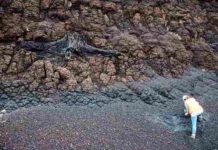
Two new studies in the Journal of Quaternary Science refute the hypothesis that one or more comets/bolides struck North America approximately 12,900 years ago triggering rapid climate change and the start of the Younger Dryas period.
Prior to the Younger Dryas, the climate had gradually warmed from glacial conditions to near modern temperatures, and the massive ice sheets in North America were in full retreat; however, approximately 12,900 years ago, temperatures rapidly plummeted and returned to glacial conditions for about a 1200 year long period. Also about this time, the mammoths and mastodons became extinct in North America.
The two papers challenge two lines of evidence reported and used by others to support the impact theory. One is the report of elevated concentrations of nanometer-sized diamonds in sediments deposited at the onset of the Younger Dryas. It is claimed that these diamonds were formed during an impact. The other is the interpretation that paleofire evidence at a key archaeological site demonstrates massive wildfires at the beginning of the Younger Dryas. It is claimed that the impact caused wildfires that spanned the continent.
Each paper shows that the evidence and interpretations supporting these two lines of arguments do not stack up. “Impact proponents report the rare form of diamond, lonsdaleite, that is usually associated with shock processing; however, we show that they misidentified polycrystalline aggregates of graphene and graphane as lonsdaleite,” said Dr. Tyrone Daulton, lead author of one of the papers. “Further, we show that the nanodiamond concentration measurements reported by impact proponents are critically flawed. There is no evidence for a spike in the nanodiamond concentration at the onset of the Younger Dryas to suggest that an impact event occurred.”
Prof. Andrew Scott, lead author of the second paper said, “The idea of a Younger Dryas impact was an interesting one that has drawn much attention; however, increasingly methodological research over the past few years has failed to corroborate that story. Our research has shown that many of the markers for such an event have been misinterpreted or misidentified.”
References:
- Tyrone L. Daulton, Sachiko Amari, Andrew C. Scott, Mark Hardiman, Nicholas Pinter, R. Scott Anderson. Comprehensive analysis of nanodiamond evidence relating to the Younger Dryas Impact Hypothesis. Journal of Quaternary Science, 2016; DOI: 10.1002/jqs.2892
- Andrew C. Scott, Mark Hardiman, Nicholas Pinter, R. Scott Anderson, Tyrone L. Daulton, Ana Ejarque, Paul Finch, Alice Carter-champion. Interpreting palaeofire evidence from fluvial sediments: a case study from Santa Rosa Island, California, with implications for the Younger Dryas Impact Hypothesis. Journal of Quaternary Science, 2016; DOI: 10.1002/jqs.2914
Note: The above post is reprinted from materials provided by Wiley.










